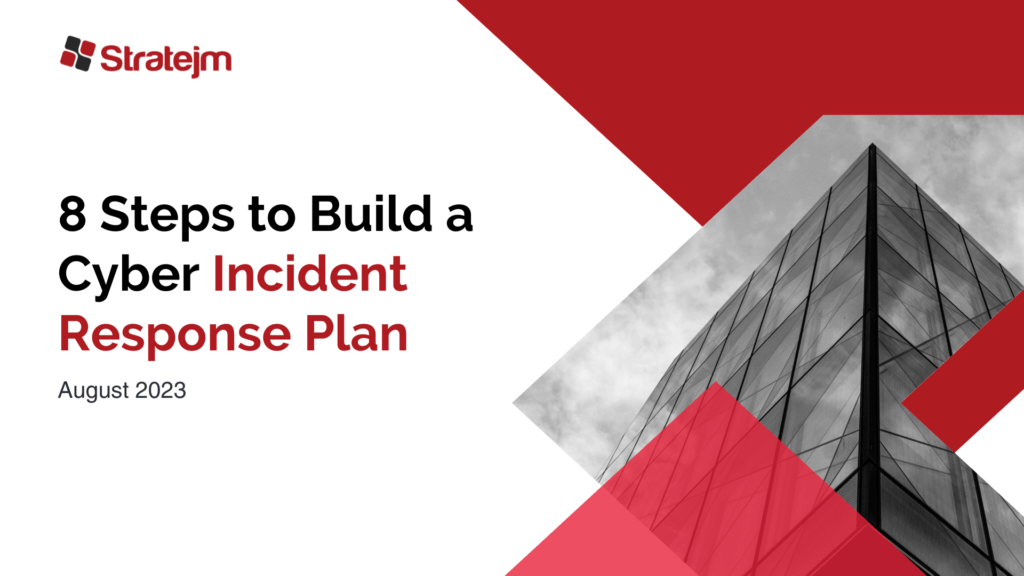The Importance of a Strong Cyber Incident Response Plan
In the modern digital landscape, the potential for cyber threats looms large, making a well-crafted incident response plan a crucial lifeline to protect your organization’s operations, reputation and data integrity.
In the following sections, we’ll delve into the core components of crafting a robust cyber incident response plan tailored to mid-sized organizations. From assembling the right team to assessing risks, identifying incidents to crafting response strategies, we’ll guide you through each step of the process.
Let’s dive in.
Building your Incident Management Team

When it comes to building a strong cyber incident response plan for your organization, a crucial first step is assembling the right team to lead the charge.
Make sure to consider the following when building your team:
- Team Composition: Begin by identifying key individuals who will form the core of your incident response team. This team should ideally include representatives from IT, cybersecurity, legal, communication, and executive leadership to ensure your response strategy is well-rounded and comprehensive.
- Roles and Responsibilities: Clearly define roles and responsibilities for each team member. Who is responsible for technical analysis and containment? Who will handle communication with stakeholders and regulatory bodies? Having well-defined roles minimizes confusion during high-pressure situations and ensures efficient decision-making.
- Chain of Command: Establish a clear chain of command within the incident response team. Determine who holds the ultimate decision-making authority and the protocol for escalating issues when necessary.
- Communication: Effective communication is vital during an incident. Set up communication channels that facilitate rapid information sharing among team members like dedicated communication tools, contact lists, and predefined channels for different types of updates.
- Training and Preparation: Regularly train your incident response team through tabletop exercises and simulations.
Assessing Risks for Effective Incident Response
 Effective incident response hinges on a solid understanding of your organization’s vulnerabilities and potential threats. Here’s how to streamline risk assessment for swift, tailored action:
Effective incident response hinges on a solid understanding of your organization’s vulnerabilities and potential threats. Here’s how to streamline risk assessment for swift, tailored action:
- Comprehensive Risk Assessment: Begin by conducting a comprehensive risk assessment that takes into account various factors. Consider your organization’s assets, both digital and physical, as well as potential entry points that cybercriminals might exploit. Evaluate the sensitivity of the data you handle, the criticality of your systems, and any third-party dependencies.
- Threat Landscape Analysis: Research prevalent attack vectors and the tactics, techniques, and procedures employed by cybercriminals.
- Historical Data Analysis: Examine past incidents, near misses, and vulnerabilities that have been discovered and addressed. Look for recurring patterns, potential weak points, and areas that require additional protection.
- External and Internal Factors: Consider external factors such as industry trends, geopolitical events, and emerging technologies that might impact your organization’s risk landscape. Also, examine internal factors like changes in infrastructure, personnel, or business operations that could introduce new vulnerabilities.
- Prioritization: Not all risks are equal. Use a risk assessment framework to prioritize risks based on factors like likelihood, impact, and the organization’s risk tolerance. This prioritization guides your incident response efforts, ensuring that you focus on addressing the most critical threats first.
- Resource Allocation: Understand the resources required for effective incident response. This includes personnel, technology, tools, and budget. By aligning your resources with identified risks, you can ensure that you’re adequately prepared to address potential incidents.
- Risk Mitigation Strategies: For each identified risk, develop mitigation strategies. These strategies should outline preventive measures, detection methods, and response plans that align with the level of risk posed by each threat.
- Scenario Planning: Consider various scenarios that could lead to cyber incidents, such as data breaches, ransomware attacks, or insider threats. Develop response strategies tailored to each scenario, so you’re prepared to take swift action if any of them materialize.
This proactive approach empowers you to address vulnerabilities before they’re exploited and helps you build a resilient defense against the ever-evolving landscape of cyber threats.
Identifying and Classifying Cyber Incidents
Identifying and Classifying Cyber Incidents starts with vigilant monitoring and evolves into a systematic classification of incidents based on their severity and potential impact. Here are the steps you need to take to streamline the process:
- Continuous Monitoring: Vigilantly watch network activity, logs, and behavior for anomalies.
- Indicators of Compromise: Use known IoCs to flag potential threats.
- Behavioral Analysis: Detect deviations from normal behavior.
- Incident Triage: Assess incident nature and impact.
- Incident Classification: Categorize by severity using predefined levels.
- Communication Channels: Establish reporting avenues for swift action.
- Incident Logging: Document events, actions, and outcomes for analysis.
- Response Activation: Activate teams based on incident risk.
- Legal Considerations: Factor legal obligations into your process.
- Training and Drills: Enhance skills through regular practice.
Creating Tailored Response Strategies

In order to create effective response strategies, they must align with the incident’s severity, type, and potential impact. Here is a brief overview on how to optimize your resources and response efforts:
- Incident-Specific Approaches: Recognize that different incidents demand different responses. A data breach requires distinct actions compared to a malware infection or a denial-of-service attack. Tailor your response playbook accordingly.
- Severity-Based Escalation: Establish a tiered response model that escalates based on incident severity. Define thresholds that trigger increased resource allocation and senior management involvement for high-severity incidents.
- Technical and Communication Plans: For each incident type, outline technical response steps. This could involve isolating affected systems, restoring backups, or quarantining malicious code. Simultaneously, define communication strategies for stakeholders, ensuring timely and accurate updates.
- Legal and Regulatory Compliance: Develop response strategies that align with legal obligations and regulatory requirements. This is crucial for incidents involving sensitive data, ensuring you navigate legal complexities appropriately.
- Collaboration and External Engagement: Determine when and how to involve third-party experts, law enforcement, or incident response partners. Collaboration can provide specialized expertise and resources that enhance your response.
- Resource Allocation: Assign responsibilities and allocate resources based on incident type. Technical teams, legal advisors, and communication experts each play a role in executing tailored strategies.
- Timelines and Milestones: Set realistic response timelines for each incident type. Define key milestones to gauge progress and ensure the incident is contained and resolved within acceptable timeframes.
- Lessons Learned Integration: Continuously improve response strategies based on post-incident analysis. Incorporate insights gained from each incident into refining future strategies.
- Testing and Validation: Regularly test your tailored strategies through simulated incident scenarios. These drills identify areas for improvement and ensure your teams are well-versed in executing their roles.
- Adaptability: Acknowledge that the threat landscape evolves. Ensure your tailored strategies are adaptable to new threat vectors and attack methodologies.
Define Containment & Mitigation Strategies
This is where you shield your organization from the escalating impact of cyber incidents. Here is a brief overview of the steps you should take:
- Isolation and Quarantine: The moment an incident is identified, swiftly isolate affected systems to prevent the incident from spreading further. Quarantine compromised assets, preventing them from interacting with unaffected parts of your network.
- Disconnection from Network: If necessary, disconnect compromised systems from your network. This step halts the potential spread of malware or unauthorized access.
- Patch and Update: Address vulnerabilities that may have been exploited during the incident. Apply patches and updates to affected systems to close off entry points.
- Data Recovery: Restore compromised data from backups, ensuring data integrity and minimizing potential data loss.
- Malware Removal: Utilize antivirus and anti-malware tools to detect and remove malicious software from affected systems.
- Digital Forensics: Conduct digital forensics to understand the extent of the breach and trace its origin. This analysis informs your containment and mitigation efforts.
- User Credential Resets: If user accounts have been compromised, enforce password resets to prevent unauthorized access.
- Communication Management: Ensure that clear communication channels are established within your organization. Keep stakeholders informed about the incident, its impact, and the steps being taken for containment and mitigation.
- Post-Incident Analysis: As containment and mitigation progress, initiate a post-incident analysis to identify gaps and areas for improvement. Use these insights to refine your strategies.
- Business Continuity: While containing and mitigating the incident, maintain focus on maintaining essential business operations. Implement your business continuity plan to minimize disruption.
- Legal Considerations: Align your strategies with legal obligations and regulatory requirements. Adhere to data breach reporting if necessary.
- Documentation: Maintain detailed records of actions taken during containment and mitigation. These records aid in post-incident analysis and compliance reporting.
Define Data Breach Recovery Steps
In the unfortunate event that there is a security incident, rapid recovery of key assets is crucial. Here is a quick guide to navigate the aftermath:
- Containment: Isolate compromised systems to halt breach spread.
- Forensic Analysis: Investigate breach scope and origin.
- Notify Stakeholders: Inform internal teams, management, and legal.
- Legal Compliance: Follow data breach reporting requirements.
- Communication: Notify affected customers transparently.
- Data Restoration: Restore data from secure backups.
- Security Enhancements: Strengthen controls and encryption.
- Account Monitoring: Watch for unauthorized access.
- Education: Train staff on breach prevention.
- Review and Learn: Analyze the breach response for improvement.
- Long-Term Monitoring: Stay vigilant for future threats.
Implement Employee Training for Cybersecurity Awareness
 Your organization is only as strong as the workers who face the threats on the frontline. While awareness training can be a complex topic, here are some key items to focus on:
Your organization is only as strong as the workers who face the threats on the frontline. While awareness training can be a complex topic, here are some key items to focus on:
- Cybersecurity Fundamentals: Teach common threats and their consequences.
- Phishing Awareness: Spot suspicious emails and links.
- Password Security: Embrace strong passwords and multi-factor authentication.
- Safe Browsing: Navigate the web cautiously.
- Data Handling: Adhere to data protection rules.
- BYOD Guidelines: Secure personal devices for work.
- Social Media Caution: Understand risks of oversharing.
- Incident Reporting: Report anomalies promptly.
- Simulated Phishing Tests: Regularly practice identifying phishing attempts.
- Continuous Learning: Keep up with evolving threats.
- Positive Culture: Foster a security-conscious environment.
Collaborating with Third Party Solutions
In the dynamic realm of cybersecurity, a solo approach may not always suffice. Collaborating with trusted third-party solutions can infuse your organization with specialized expertise, resources, and technologies that complement your in-house capabilities.
By forging these strategic partnerships, you enhance your ability to detect, prevent, and respond to cyber threats effectively:
- Threat Intelligence Providers: Partner with threat intelligence services that offer real-time insights into emerging threats and attack trends. This knowledge equips you with the foresight to proactively adapt your defenses.
- Managed Security Service Providers (MSSPs): MSSPs like Stratejm offer a range of services, from continuous monitoring to incident response. They bring external expertise to your team, augmenting your security posture.
- Security Software Vendors: Leverage advanced security software solutions that align with your organization’s needs. These tools can automate threat detection, enhance network visibility, and streamline incident response.
- Cybersecurity Consultants: Engage consultants who can conduct thorough security assessments, identify vulnerabilities, and provide tailored recommendations for improvement.
- Incident Response Experts: In the event of an incident, having a dedicated incident response team on standby can significantly reduce response time and mitigate damage.
- Threat Hunting Services: Collaborate with professionals who actively seek out hidden threats within your network, identifying and neutralizing potential breaches before they escalate.
- Employee Training Specialists: Enlist experts to conduct engaging and informative employee cybersecurity training sessions. This ensures your workforce remains a well-informed defense against social engineering tactics.
- Legal and Compliance Advisors: In the face of a breach, legal experts can help you navigate complex data breach notification regulations and ensure compliance.
- Cyber Insurance Providers: Cyber insurance offers financial protection in the aftermath of a breach. Partner with providers who understand your organization’s unique risks.
- Technology Integration Partners: Ensure seamless integration of third-party solutions with your existing technology stack to maximize efficiency and effectiveness.
Collaboration with third-party solutions expands your organization’s expertise and capabilities beyond what’s achievable in-house. By tapping into external resources, you gain a comprehensive and versatile cybersecurity approach that can keep pace with the ever-evolving threat landscape. As we continue, discover how these collaborative efforts harmonize with effective communication strategies for a holistic incident response approach.


